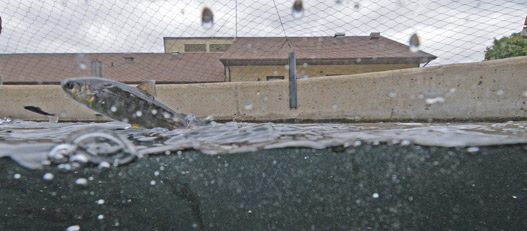Wells
Water for the hatchery comes from one of two alternately run deep wells. Each well is rated for 750 gallons per minute (gpm).
Incubators
Eggs are placed into special screened trays for incubation. About 10,000 to 14,000 eggs are loaded into each tray. The hatchery has 18, eight-tray incubator stacks. Each stack receives five gallons of water per minute. Egg incubation time depends upon the species cultured and water temperature. Normally, hatching occurs in about 30-40 days. After hatching, the fry use yolk stored in their sac as a food supply for about 20 days.
Indoor Raceways
Small fry, known as swim-ups, are transferred to concrete linear raceways when they have nearly absorbed their yolk sac and are strong enough to swim freely. From this moment until the fish are released from the hatchery, they are carefully fed specialized high protein diets. Initial feed training is extremely important in their lives. Frequent feedings from the automatic feeders suspended above each raceway increase the success for these fish to accept food they would not find in nature.
Circular Ponds
Fingerlings are transferred to outside circular ponds shortly after they reach 2 inches. Initially, they occupy only a small portion of the rearing area. As the fish grow, they are split into additional ponds to provide adequate space and oxygen. Each day, automatic feeders are filled with the proper size and quantity of feed. Feed adjustments continue until the fish reach stocking size. Although stocking strategies may change, typically there is a small number of fish stocked in the fall while the majority are released early spring. Regardless of the time of year these fish are planted, they will imprint to their stocking waters (smoltification) in late spring before migrating to Lake Michigan.
Broodstock Tanks
These tanks hold the adult Skamania steelhead described in the Egg Sources section under the Fish Culture tab. The collection period for bringing these future spawners to the hatchery will depend on water temperatures in Trail Creek and Lake Michigan. Typically, broodstock are harvested from late June through mid-to-late August. The hatchery’s goal is to fill these tanks with 700 fish, 450 will be female and 250 will be male. The differentiation between the two sexes is with the shape of the head. Females have a shorter, more rounded snout, while males have a longer and somewhat pointed snout. Eggs are taken once a week from early January through mid-February. About a month after the last group of eggs is collected, surviving adults are released into the St. Joseph River.
Biofilters
Bodine operates on a recirculating aquaculture system (RAS). At peak capacity, about 3750 gpm is needed to keep all the fish alive. To accommodate this need, an elaborate filter system is required to clean used water from the linear raceways and circular ponds. The filter uses naturally occurring good bacteria that live in a bed of a man-made rock known as haydite. This six-cell biofilter system removes waste products from the hatchery’s production water supply, allowing it to be recirculated by high capacity pumps.
Lagoon
Water wasted from rearing tank and biofilter cleaning leaves the hatchery through a two-stage settling lagoon. Operation of the lagoon is similar to a primary sewage treatment plant. Oxygen levels are maintained to complete chemical and biological breakdown. A sedimentation area is provided for solids to settle out of the water column before discharge from the hatchery grounds.

